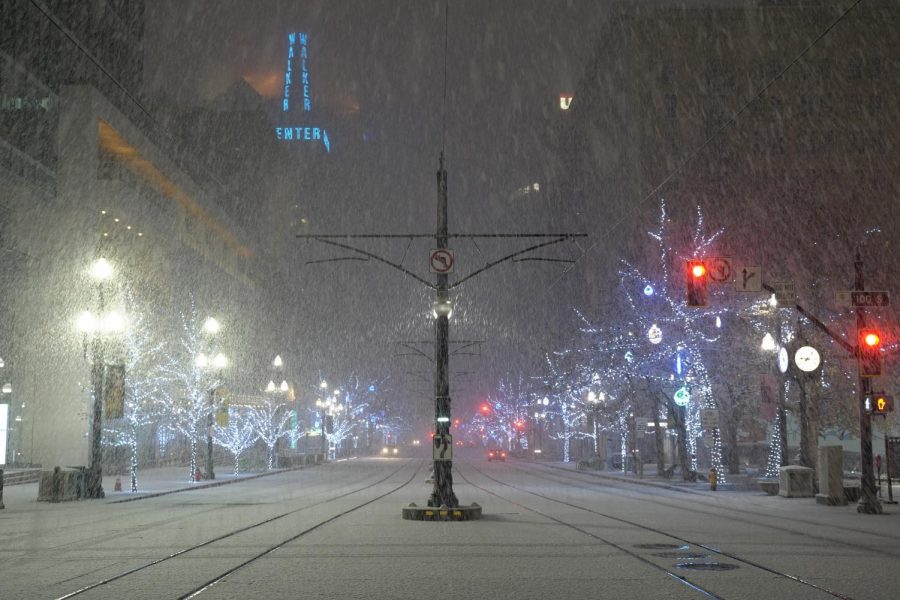Shadley: Let’s Revitalize Utah’s Main Streets
Snowfall at the downtown Salt Lake City on a Christmas night on Dec. 25, 2018 (Photo by Abu Asib | The Daily Utah Chronicle)
February 25, 2021
This past year, devoid of meaningful interaction with acquaintances, has demonstrated the value of community. Much more than simply a place where we run errands and then quickly retreat to the confines of our home, a community is a place where we recreate, engage in economic activity, eat the food of other cultures, experience art and, most importantly, fulfill the primal human instinct to belong to something greater than ourselves. The difficulty of doing so has heightened during the pandemic, but for many Utahns, interacting with their local community wasn’t necessarily easy beforehand either.
It’s no secret that Utah’s rural communities are struggling economically, primarily due to a lack of high-quality job opportunities. However, a post-coronavirus world, with far more work-from-home positions than before, will allow urban workers the ability to move into rural communities. These newcomers, with their city-salaries, will provide an economic stimulus to support local businesses and the same can be said for the people already living in rural communities now working remote positions.
The problem, however, is how we can build rural communities that are places people want to move to. In the current legislative session, S.B. 194 aims to create the Utah Main Street Program, which would provide a pathway to revitalizing Utah’s main streets. That revitalization would honor the historical value of those streets while creating walkable, people-centered downtowns that are resilient to climate change, but only if we do it correctly.
As part of the Utah Main Street Program, the state would have the option to join Main Street America’s National Main Street Center, which is a network of grassroots and local organizations across the country that have committed to improving the quality of life at the city, county and state-level through street revitalization. Programs of Main Street America commit to the three principles of celebrating community character, preserving local history and generating impressive economic returns. To learn more about Main Street America and what it would look like in Utah, I reached out to Larry Lucas, the Main Street Architect for Colorado. Lucas oversees 51 communities, and he has seen firsthand the way that revitalization projects can completely transform a downtown area.
In the small town of Brush!, Colorado (yes, there is an exclamation point in the town’s name), the Colorado Main Street Program spent three years rehabilitating the Sands Theatre, which had fallen into a “state of disrepair” and could not be used. Now, the Sands Theatre has “three showings a week” and you would “not know that it had ever not been running.” The revenue from those showings goes back into the preservation of the theatre to ensure it never falls into an unusable state again. Rehabilitated properties, like the Sands Theatre and adjacent businesses, have more “first-time customers and repeat customers.” This greater traffic leads to increased economic activity in a town and, more importantly, allows the residents to “feel a sense of pride in their community again.”
That sense of pride in the community doesn’t just stem from there being a new beautiful building or streetscape downtown. That’s part of it, but the real reason is that Main Street America is a “grassroots organization with local people actually volunteering to make the program a success.” By allowing the people who actually live there to have a hand in the process, Main Street America’s community-led revitalization approach allows for a more equitable and economically strong future for our communities.
The downtown main street in Price is going to look very different from the main street in West Valley City, and that’s something we should embrace. Designing cities and streets to fit the needs of the people who actually live there not only benefits the residents, but also visitors who can expect a unique experience from each of our state’s towns. To be successful, Utah’s Main Street Program will need to work with community leaders, residents, and organizations to reduce the negative effects of gentrification, produce places and streets that people will actually want to use, and adapt to the various challenges that the climate crisis will bring to our state.
In some of Utah’s counties, summer temperatures are rising at rates twice the national average due to climate change. If Utahns, and tourists, are going to be able to enjoy the revitalized streets that the Utah Main Street Program would produce, green infrastructure will have to be incorporated into the projects. The primary focus, especially in those hotter climates, will be reducing the urban heat island effect, where areas with dense concentrations of asphalt, buildings, and other gray infrastructure absorb and retain more heat from the sun.
One of the main ways to reduce heat in a downtown area is by adding trees, green roofs, and vegetation wherever possible. Colorado is already working towards including a “new energy preservation program,” which is helpful for reducing emissions, but to deal with the inevitable temperature increases of the future, we must look to include green infrastructure as a central tenet of Utah’s Main Street Program.
S.B. 194 is still working its way through the legislature, but if it passes, the first thing the state should do is join Main Street America’s network. The introduction of a Main Street Program is a crucial step towards building back from the pandemic and designing resilient cities for the climate crisis, especially in rural areas.
As we look to find ways to produce greater equity within our cities and towns, a new “work from home” labor force, a community-led revitalization program, and a green approach to designing our streets offer up a path forward where we can be proud of our communities. That pride is only possible when we work together with our neighbors to satisfy that human need to build something that is bigger than ourselves. Larry Lucas is looking forward to having Utah as a “new neighbor.” Likewise, Larry.








